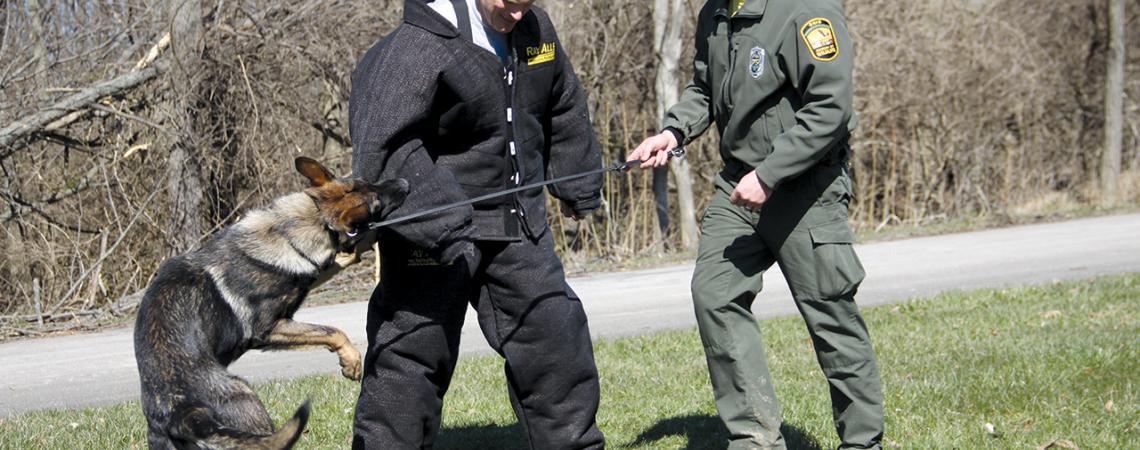K-9 officer Mattis trains with ODNR officers Chris Gilkey and Jeremy Carter (in the “bite suit”).
As hunting seasons open this fall, the Ohio Department of Natural Resources (DNR), Division of Wildlife will have five more wildlife officers patrolling the state’s woods, fields, and marshes. Unlike the other 100 or so state wildlife officers, the new recruits will have cold, wet noses and wagging tails; they’re K-9s.
For the first time in its nearly 70-year history, the Ohio DNR has joined more than 20 other state conservation agencies in employing K-9 officers. During the past year, five dogs and their handlers have been trained and assigned — one per wildlife district.
Selected for the specialized duty were veteran state wildlife officers Jeremy Carter, Josh Elster, Chris Gilkey, Jason Keller, and Matt Leibengood. Their furry partners are Finn, Mila, Mattis, Scout, and May, respectively — three German shepherds and two Labrador retrievers. All five dogs are less than 2 years old and were purchased with donations from the Division of Wildlife’s many conservation partners and sponsors.
“The dogs were trained to detect six different scents — gunpowder, waterfowl, turkey, deer, and fish, as well as ginseng,” says Gilkey. Ginseng is a highly regulated plant that grows wild in the eastern U.S., including Ohio, and its roots are frequently dug illegally, out of season, by poachers.
“The temptation is the root’s high market value — anywhere from $300 to $900 per dried pound,” Gilkey says. “These dogs will be a great tool in helping us win the fight against ginseng poaching in Ohio, as well as against fish and game poachers in general.”
For instance, in an illegal road-shooting case during this year’s spring turkey-hunting season, Mattis helped locate two shotgun shell wads and the wounded turkey. “He located the first wad, which had been in the pouring rain, within five minutes, and he found the second wad 15 minutes later,” Gilkey says. “Mattis also had one apprehension where his mere barking made the suspected poacher give up and comply with my commands.” Mattis was born and raised in Germany, so Gilkey has to speak to the dog in German to give it commands.
The new K-9s will assist other law enforcement agencies as well. For instance, just a month after graduation, Carter and Finn were called to the location of an alleged assault, and Finn located crucial evidence within only a few minutes of arrival.
The Division of Wildlife also looks to capitalize on the public relations value of the dogs. “Most everyone loves dogs,” says Gilkey, “so we plan to use the K-9 officers as a way to make contact with those people who may not necessarily hunt or fish, including school kids. The dogs will give us many opportunities to tell our story of what we do as a state agency in managing Ohio’s wildlife.”
According to Gilkey, wildlife law enforcement is statistically the most dangerous law enforcement job in the world, mainly because most wildlife officers work alone much of the time, with any potential backup many minutes and miles away. “But now with Mattis, I have backup with me full time,” he says.
“If I’m away from my vehicle and have left my dog inside, and I become involved in a life-threatening situation — an altercation with a poacher, for instance — I can push the deploy button on a pager on my belt and the doors to my vehicle swing open. The dog is then trained to immediately track me by scent and come to my aid, protecting me from an assailant, if necessary. That’s a very comforting feeling.”
W.H. “Chip” Gross is Ohio Cooperative Living‘s outdoors editor.









